Home PageAbout MindatThe Mindat ManualHistory of MindatCopyright StatusWho We AreContact UsAdvertise on Mindat
Donate to MindatCorporate SponsorshipSponsor a PageSponsored PagesMindat AdvertisersAdvertise on Mindat
Learning CenterWhat is a mineral?The most common minerals on earthInformation for EducatorsMindat ArticlesThe ElementsThe Rock H. Currier Digital LibraryGeologic Time
Minerals by PropertiesMinerals by ChemistryAdvanced Locality SearchRandom MineralRandom LocalitySearch by minIDLocalities Near MeSearch ArticlesSearch GlossaryMore Search Options
The Mindat ManualAdd a New PhotoRate PhotosLocality Edit ReportCoordinate Completion ReportAdd Glossary Item
Mining CompaniesStatisticsUsersMineral MuseumsClubs & OrganizationsMineral Shows & EventsThe Mindat DirectoryDevice SettingsThe Mineral Quiz
Photo SearchPhoto GalleriesSearch by ColorNew Photos TodayNew Photos YesterdayMembers' Photo GalleriesPast Photo of the Day GalleryPhotography
╳Discussions
💬 Home🔎 Search📅 LatestGroups
EducationOpen discussion area.Fakes & FraudsOpen discussion area.Field CollectingOpen discussion area.FossilsOpen discussion area.Gems and GemologyOpen discussion area.GeneralOpen discussion area.How to ContributeOpen discussion area.Identity HelpOpen discussion area.Improving Mindat.orgOpen discussion area.LocalitiesOpen discussion area.Lost and Stolen SpecimensOpen discussion area.MarketplaceOpen discussion area.MeteoritesOpen discussion area.Mindat ProductsOpen discussion area.Mineral ExchangesOpen discussion area.Mineral PhotographyOpen discussion area.Mineral ShowsOpen discussion area.Mineralogical ClassificationOpen discussion area.Mineralogy CourseOpen discussion area.MineralsOpen discussion area.Minerals and MuseumsOpen discussion area.PhotosOpen discussion area.Techniques for CollectorsOpen discussion area.The Rock H. Currier Digital LibraryOpen discussion area.UV MineralsOpen discussion area.Recent Images in Discussions
Improving Mindat.orgFake gold specimen
17th Feb 2016 21:56 UTCReiner Mielke Expert

17th Feb 2016 22:04 UTCAlfredo Petrov Manager
17th Feb 2016 22:10 UTCReiner Mielke Expert

17th Feb 2016 22:17 UTCAlfredo Petrov Manager

17th Feb 2016 23:08 UTCRanger Dave

17th Feb 2016 23:25 UTCKen Doxsee

17th Feb 2016 23:29 UTCsteven garza
What Reiner is the SPECIMEN is "fake", not the gold, itself. What is pictured is NOT how the specimen came out of the ground, as; if someone was to try to sell it to you, as being found naturally that way, THEN, it's a fake (as well as a fraud). Before roasting, the gold was tiny inclusions in pyrite or grayish gold bearing sulphosalts, but, the roasting frees the golds, which aggregates into small beads, scattered about the matrix; if it's done skillfully enough, it can look COMPLETELY natural, to the untrained eye.
Your friend, Steve

17th Feb 2016 23:38 UTCBob Harman
Some folks on this thread seem a bit too narrow minded. Real and genuine gold bars are just another form of gold from crystallized gold specimens. Other minerals such as silver bars, platinum bars, and various cut colored stones and diamonds also should be similarly accepted onto the Mindat site. Anyone go the big national shows and see an exhibitor case of the mineral specimen along side of a cut and faceted stone? This could easily include a gold specimen along side of a refined ounce of gold.
CHEERS......BOB

17th Feb 2016 23:58 UTCAlfredo Petrov Manager
As the temperature of decomposition of cinnabar is higher than the boiling point of mercury, I expect that attempts to "sweat" it out of cinnabar would just result in a lot of gaseous mercury fumes, ie the complete loss of the elemental mercury. (But I haven't done the experiment either.)

18th Feb 2016 00:25 UTCRudy Bolona Expert
18th Feb 2016 00:38 UTCReiner Mielke Expert
18th Feb 2016 01:07 UTCPaul Brandes 🌟 Manager
18th Feb 2016 01:48 UTCReiner Mielke Expert
No problem unless you want them for free or are short on cash or credit ;-)

18th Feb 2016 03:24 UTCRanger Dave
-------------------------------------------------------
> Dear Ranger;
>
> What Reiner is the SPECIMEN is "fake", not the
> gold, itself. What is pictured is NOT how the
> specimen came out of the ground, as; if someone
> was to try to sell it to you, as being found
> naturally that way, THEN, it's a fake (as well as
> a fraud). Before roasting, the gold was tiny
> inclusions in pyrite or grayish gold bearing
> sulphosalts, but, the roasting frees the golds,
> which aggregates into small beads, scattered about
> the matrix; if it's done skillfully enough, it can
> look COMPLETELY natural, to the untrained eye.
>
> Your friend, Steve
Oh, I see... the quartz crystals I just soaked in IronOut are now fake since that's not how they came out of the ground. And, thanks for the insult in assuming I'm too stupid to know where gold comes from.

18th Feb 2016 03:28 UTCRanger Dave
18th Feb 2016 03:32 UTCJolyon Ralph Founder

18th Feb 2016 06:34 UTCsteven garza
I'm sorry you assumed I was insulting you, but, since most gold specimens DON'T need any roasting yet are usually HF acid relieved, that are real, your comments seemed to show you didn't understand that difference. Quartz xls soaked in Iron Out (or gold relieved from quartz/calcite matrix) isn't changed in form or structure; they're just considered "cleaned" - the same as if you washed some dirt off a fine quartz cluster.
Your friend, Steve

18th Feb 2016 09:12 UTCErik Vercammen Expert
18th Feb 2016 12:26 UTCUwe Kolitsch Manager

18th Feb 2016 13:24 UTCJohn Collins
In my mineral collection, all specimens are as they came out of a mine or out of the ground by my hands. There are no faceted gem minerals nor smelted metals. The only exceptions are my polished agates and schalenblende.
That said, I would not turn away any samples of gold bars but they would be stored elsewhere until converted into a cache of cash.
Regards,
John

18th Feb 2016 14:07 UTCLarry Maltby Expert
When I went to post it I found that the problem was already solved. The photo was placed in the “other” category and was added to the Cripple Creek location page as miscellaneous information. Ah heck, I can’t get a word in edgeways! :-D
18th Feb 2016 15:26 UTCReiner Mielke Expert

18th Feb 2016 16:38 UTCRanger Dave
-------------------------------------------------------
> Dear Ranger;
>
> I'm sorry you assumed I was insulting you,
Such condescension is always intended as an insult and should always be taken as such. Roasting occurs at 350 degrees F. Gold melts much higher so it cannot be "roasted."
18th Feb 2016 22:02 UTCReiner Mielke Expert
https://en.wikipedia.org/wiki/Roasting_(metallurgy)

18th Feb 2016 23:03 UTCDoug Schonewald
For those that know the processes this is not a tutorial. Many, I think, do not understand this process and hopefully this helps.

19th Feb 2016 00:39 UTCRanger Dave
-------------------------------------------------------
> "Roasting occurs at 350 degrees F. Gold melts much
> higher so it cannot be "roasted."" So what do you
> call this then?
Not 'roasted'.
19th Feb 2016 00:56 UTCReiner Mielke Expert
If you don't want to call it roasted that is fine, however everyone else does.
19th Feb 2016 01:19 UTCDon Saathoff Expert
Don S.
19th Feb 2016 01:29 UTCReiner Mielke Expert
19th Feb 2016 01:35 UTCDon Saathoff Expert
Don S.

19th Feb 2016 06:25 UTCRanger Dave
-------------------------------------------------------
> I worked at a smelting complex in Northern Idaho
> for the better part of 15 years. When they roast
> ores they reach the plastic stage, not quite
> molten, but gooey, pliable, and very sticky. The
> temperature probably exceeds 650 C since the
> "roast" is bright orange red. The idea is to
> created 'cinders' so that the ores melts better in
> a larger furnace, and to utilize various ores to
> achieve a homogenous mix. Our roasting machine was
> a German invention know as a Lurgi Roaster;
> completely contained to eliminate as much of the
> inevitable dust and smoke involved with roasting
> ores. Mineral-wise roasting is an essential part
> of the smelting process.
> For those that know the processes this is not a
> tutorial. Many, I think, do not understand this
> process and hopefully this helps.
Which would be fine IF that is the way the term was being used. It was used as a way to disparage any gold that was not in the exact state that it was in when it came out of the ground. They were playing word games, so I just played it back on them. If they want to see real gold as "fake gold" then that's their problem.
19th Feb 2016 13:32 UTCReiner Mielke Expert

19th Feb 2016 13:44 UTCAlan Pribula

30th Oct 2016 19:45 UTCTimothy Nybo
My questions are these: does pH/temp effect stannous testing, what does it mean if all the color washes out to a slight blue green, does solution color effect the test, do dissolving solutions beside AR effect the test and finally is there an easier way lol...Any advice is welcomed and graciously recieved. Not a lot of useful info in this business due to propritary secrecy but I'm trying to give it back to the people. That is a long road my friends...
31st Oct 2016 11:22 UTCReiner Mielke Expert




Mindat.org is an outreach project of the Hudson Institute of Mineralogy, a 501(c)(3) not-for-profit organization.
Copyright © mindat.org and the Hudson Institute of Mineralogy 1993-2024, except where stated. Most political location boundaries are © OpenStreetMap contributors. Mindat.org relies on the contributions of thousands of members and supporters. Founded in 2000 by Jolyon Ralph.
Privacy Policy - Terms & Conditions - Contact Us / DMCA issues - Report a bug/vulnerability Current server date and time: April 23, 2024 09:15:24
Copyright © mindat.org and the Hudson Institute of Mineralogy 1993-2024, except where stated. Most political location boundaries are © OpenStreetMap contributors. Mindat.org relies on the contributions of thousands of members and supporters. Founded in 2000 by Jolyon Ralph.
Privacy Policy - Terms & Conditions - Contact Us / DMCA issues - Report a bug/vulnerability Current server date and time: April 23, 2024 09:15:24













